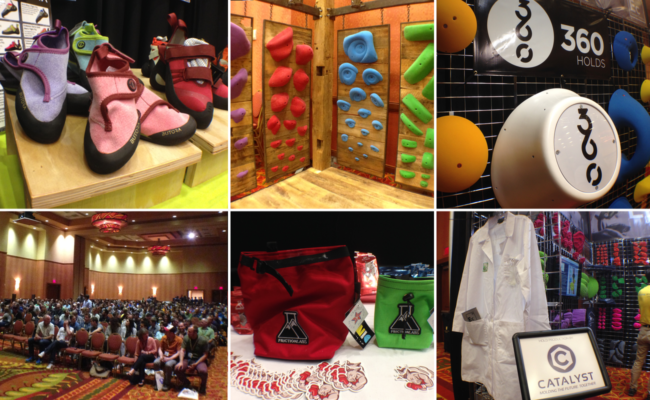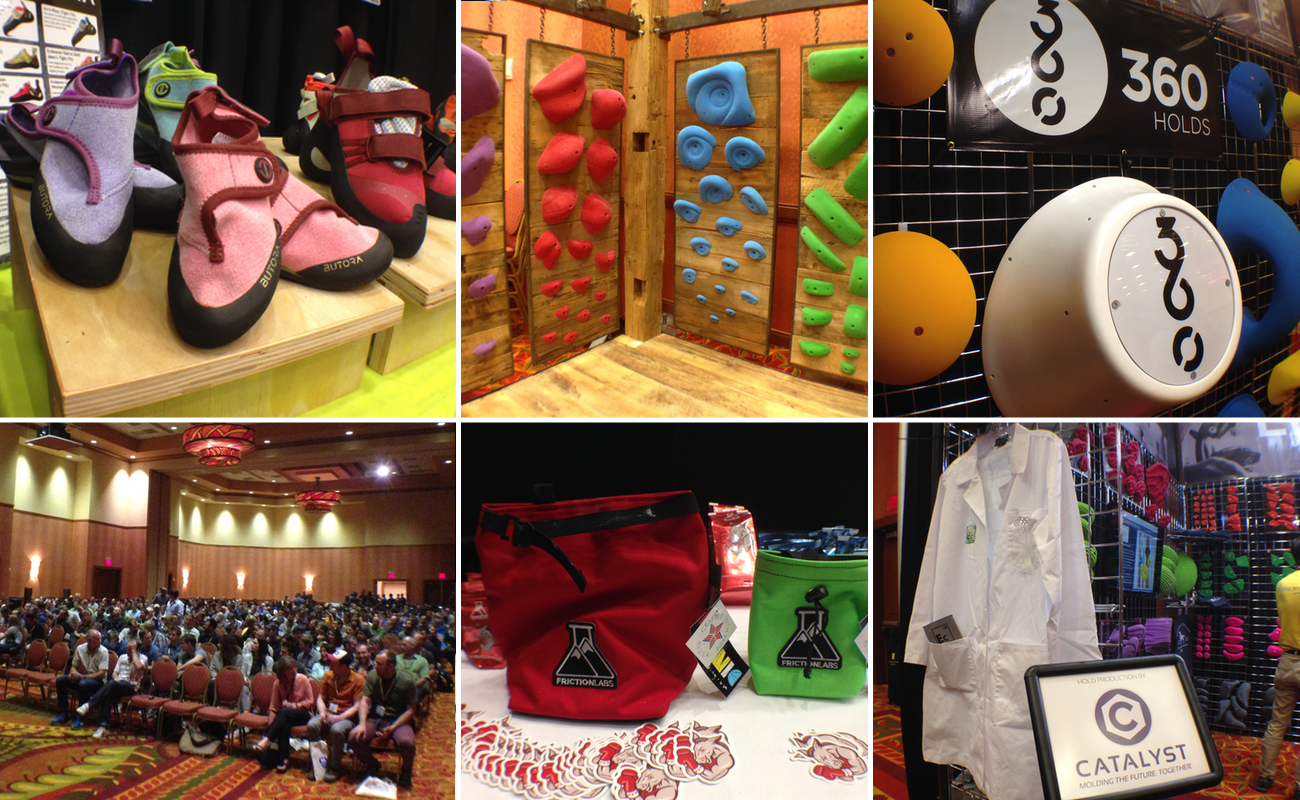
The 10th annual Climbing Wall Summit, an annual conference organized by the Climbing Wall Association, finds the indoor climbing industry at a pivotal point in history. The event, which took place this past week, attracted nearly six hundred climbing gym professionals from across the US, Canada, Australia and beyond to Loveland, Colorado for a two-day event aimed at educating and inspiring both long-time and aspirational climbing gym operators. Throughout the conference, attendees saw evidence that the business of indoor climbing is growing and changing rapidly, and is poised to enter a new era.
Climbing is Big Money
Compared to the broader health club industry, which has more than 35,000 locations across the country, the climbing gym’s ascent to nearly 400 locations in the USA (and over 70 in Canada) seems almost trivial. But the industry is growing rapidly — the expansion rate is expected to approach 15% this year — and its economic impact is already significant. According to numbers shared at the Summit, indoor climbing gyms across the US brought in more than $230 million dollars last year, and facilities have more than 200,000 combined members.
Rapid expansion doesn’t come without a set of major challenges. The trend of building large purpose-built facilities, with taller walls, more amenities and in more expensive markets means the cost of opening a gym can reach into the millions of dollars. However, most gyms are still funded by owner equity and bank loans, which can be challenging to obtain.
Many of the larger operators are getting calls from venture capital firms interested in seeing how they can get a slice of the climbing pie. But the hurdle for grabbing some VC money remains prohibitively high, according to a presentation by Bill Flaherty, a finance expert at Consumer Capital Partners. Flaherty explained that private equity firms are looking for companies with millions in cash-flow. Even if they meet this criteria, investors want a clear exit plan, and today’s climbing gym companies are too small for an IPO and suffer from a lack of interest by strategic buyers. Furthermore, the rate of growth is limited by a climbing gym’s need for specialized real estate, which takes time to locate and develop, Flaherty went on to say.
Nevertheless, many of the existing climbing gym operators at the Summit shared their intention to add additional locations, while a significant number of the attendees were hopeful entrepreneurs keen in adding their name to the growing list of climbing gym operators.
Summit Grows Too
Not surprisingly, the industry growth was mirrored by the number of people participating in the Summit. The event, which has been held in a number of different venues in Boulder, CO over the years, was relocated to a dedicated conference center an hour north to accommodate the growing number of attendees and vendors; despite the larger space the event still sold out the exhibit hall, which featured 49 different vendors, including climbing wall, padded flooring manufacturers and other companies that produce climbing holds, shoes, ropes and other gym equipment.
In addition to upgrading the venue, the CWA put a great deal of effort into improving the quality of information provided during the event. Most notably, they tweaked the schedule to include more plenary sessions featuring professionals from outside the climbing industry that helped bring a broader business perspective to an industry that is sometimes guilty of navel-gazing.

Accident Stats
A key takeaway from the Summit is how important data is becoming for an industry that is starting to be seen as more mainstream by the general public. One area of particular importance is the compilation of accident statistics by Monument Sports Group, the designated insurance provider of the CWA.
Of all incidents reported to MSG since they took over the CWA insurance program, 71% were bouldering injuries. Notably, first time and beginner bouldering participants accounted for the majority (57%) of the reported bouldering incidents.
There are several reasons for the prevalence of bouldering injuries. Foremost is the fact that in bouldering, every fall is a ground fall (because there is no rope protection), and every fall holds the potential for injury. Furthermore, bouldering is the fastest growing segment of the sport, in part due to its low barrier to entry, as climbers don’t need a partner and don’t need to learn how to belay and pass a belay test.
This points to an urgent need for climbing and bouldering-only gyms to do more to educate new climbers on the risks of bouldering, increasing knowledge on proper falling techniques and emphasizing the importance of respecting the limits of their abilities. Other suggestions for reducing injury rates on the bouldering wall included discouraging spotting (which has been shown to be ineffective and potentially dangerous in facilities with continuous, seamless padded floors), making good use of designated down-climb holds, practicing conscientious routesetting, and performing regular analysis of incident trends to determine if there is a particular routesetter, section of wall, or other factors that might be contributing to a higher incidence of injuries.
These metrics also point to a larger challenge of gathering more accurate and relevant statistics that will help individual gyms and the industry as a whole continue to evolve and minimize risk. After collecting from gyms for 2.5 years, Monument only received 225 incident reports; this represents all self-reported incidents of varying levels of severity. Most gym owners and managers hearing this statistic expressed concern that this was a very low number, and pointed to their own lack of reporting, simply due to a lack of understanding or from fear that reporting all incidents might result in higher premiums.
Mark Grossman, President of Monument stressed to audience members several times during the Summit that reporting incidents will not lead to changes in insurance rates. He and other gym owners discussed the importance of improving reporting of all accidents so the industry will have better data and can be more proactive in addressing existing and emerging accident trends.
Industry Metrics
Unlike many other industries, the indoor climbing business sector has very few metrics to track the economic growth and health of the industry. CBJ has been tracking and publishing the growth in the number of commercial climbing gyms in the USA and Canada for a few years but there are no other industry-wide metrics that can help a climbing gym operator evaluate their financial performance. All climbing gyms in North America are privately held, and there has been a longstanding reluctance of climbing gym operators to share data, even with independent groups like the CWA.
This all could change thanks to a new initiative by Rock Gym Pro, the software that most indoor climbing gyms use to track customers and sales. The Industry Metric Service (IMS) is an optional feature of the software that allows operators to opt-in to sharing anonymous aggregate data about their facility. This feature, which is currently being used by 51 commercial climbing gyms, allows facilities to compare a number of key metrics about their business to industry averages. For example, they can look at a dashboard that displays a graph of their gross sales, memberships and daily check-ins, and see how their current numbers and growth over last year compare to the national average.
Chris Warner, President of Earth Treks and a member of the CWA Board of Directors, made a plea during the final plenary for members to start participating in this data sharing program. He stressed that in order for the industry to continue maturing, businesses must have access to accurate data that can inform managers on how they are performing and to help guide operational decisions. In addition, these metrics will become incredibly important for demonstrating the economic potential of the industry for brands that are looking to attract large amounts of capital from the private sector to fund the growth of their companies.
Unfortunately for prospective gym owners, RGP has made it explicitly clear that this data will only be available to existing climbing gym operators that have opted into the program, and will not be sold to any outside parties.
On the Ledge
After three days of pre-conference workshops and two-and-a-half days of intensive conference presentations, the general mood of the attendees was one of excitement and speculation. Many gym operators and those wishing to start their first gym expressed a sense of the industry entering a new phase; a tipping point in where and how climbing is sold.
Though none could point exactly to where the industry is headed, all those paying attention notice a shift in the competitive atmosphere. A shift that could force climbing businesses to step up their game in an effort to stay relevant, and in business.

Climbing Business Journal is an independent news outlet dedicated to covering the indoor climbing industry. Here you will find the latest coverage of climbing industry news, gym developments, industry best practices, risk management, climbing competitions, youth coaching and routesetting. Have an article idea? CBJ loves to hear from readers like you!






